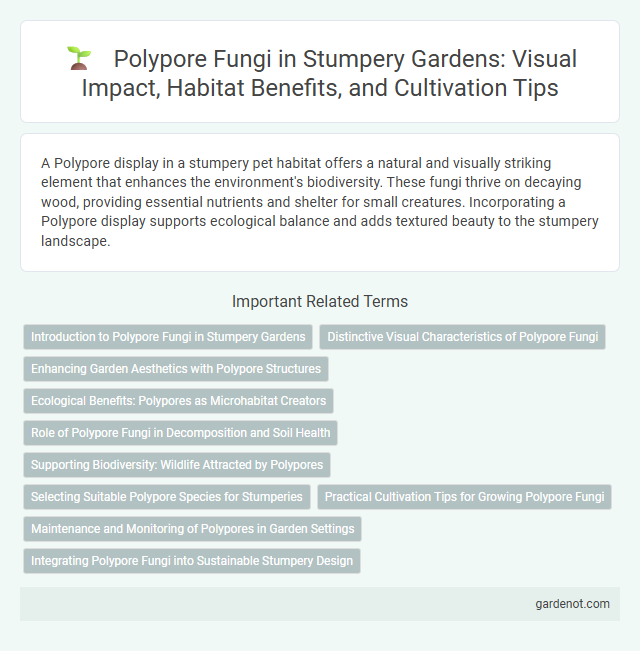A Polypore display in a stumpery pet habitat offers a natural and visually striking element that enhances the environment's biodiversity. These fungi thrive on decaying wood, providing essential nutrients and shelter for small creatures. Incorporating a Polypore display supports ecological balance and adds textured beauty to the stumpery landscape.
Introduction to Polypore Fungi in Stumpery Gardens
Polypore fungi, commonly found on decaying wood, play a vital role in stumpery gardens by breaking down tough lignin and cellulose, facilitating nutrient cycling. Their distinct bracket-shaped fruiting bodies create visually striking displays, enhancing the rustic aesthetic of stumperies while supporting woodland biodiversity. Incorporating polypores like artist's conk (Ganoderma applanatum) and turkey tail (Trametes versicolor) adds both ecological value and textural variety to stumpery collections.
Distinctive Visual Characteristics of Polypore Fungi
Polypore fungi showcase a unique visual structure characterized by their tough, woody brackets with pores underneath instead of gills, providing a spongy texture that enhances the aesthetic of a stumpery. Their varied colors range from earthy browns and creamy whites to vibrant oranges and yellows, adding rich visual diversity to woodland displays. The concentric rings and textured surfaces of polypores contribute to an intricate, natural sculpture effect, making them a focal point in stumpery arrangements.
Enhancing Garden Aesthetics with Polypore Structures
Polypore structures in a stumpery create visually striking focal points by showcasing the diverse shapes and textures of shelf fungi on decaying wood, enriching the garden's natural aesthetic. These fungi contribute to biodiversity while adding rustic charm through their layered, bracket-like formations that contrast with greenery. Integrating polypore displays enhances the organic complexity of woodland gardens, promoting a harmonious blend of art and ecology.
Ecological Benefits: Polypores as Microhabitat Creators
Polypores, a key element in stumpery displays, serve as vital microhabitat creators by providing shelter and breeding grounds for numerous invertebrates, fungi, and microorganisms. Their porous structures retain moisture, fostering biodiversity and supporting complex ecosystems within decaying wood. This ecological function contributes to forest health by accelerating decomposition and nutrient cycling.
Role of Polypore Fungi in Decomposition and Soil Health
Polypore fungi play a crucial role in the decomposition of dead wood by breaking down lignin and cellulose, which accelerates nutrient recycling in forest ecosystems. Their ability to degrade complex organic materials contributes significantly to soil formation and enhances soil health by releasing essential minerals and improving soil structure. In a stumpery, displaying polypores highlights their ecological importance in maintaining ecosystem balance and supporting biodiversity.
Supporting Biodiversity: Wildlife Attracted by Polypores
Polypore fungi provide critical habitats and food sources for diverse wildlife, including insects, birds, and small mammals, enhancing forest biodiversity. Their presence in stumperies supports complex ecosystems by offering shelter and nourishment, which helps sustain various species throughout different life stages. By fostering polypore growth, stumperies contribute to ecological balance and promote the conservation of woodland fauna.
Selecting Suitable Polypore Species for Stumperies
Selecting suitable polypore species for stumperies involves identifying fungi with robust, shelf-like fruiting bodies that thrive on decaying wood. Common choices include Ganoderma lucidum, Fomes fomentarius, and Trametes versicolor due to their distinctive textures and colors that enhance aesthetic appeal while supporting biodiversity. These species contribute to natural decomposition processes, creating dynamic habitats for insects and microorganisms within the stumpery ecosystem.
Practical Cultivation Tips for Growing Polypore Fungi
Polypore fungi thrive in shaded, moist environments with plenty of decaying hardwood, making stumperies ideal for their cultivation. Maintaining consistent dampness by misting and using decomposing logs as substrate promotes robust fruiting bodies. Monitoring temperature between 15-25degC and ensuring adequate airflow prevents mold while encouraging healthy polypore growth.
Maintenance and Monitoring of Polypores in Garden Settings
Regularly inspecting polypore fungi for signs of decay or pest infestation is crucial to maintaining their health in garden stumperies. Ensuring optimal moisture levels and airflow around polypore displays helps prevent fungal rot and promotes sustainable growth. Periodic removal of dead or damaged fungal fruiting bodies supports the longevity and aesthetic appeal of polypore collections.
Integrating Polypore Fungi into Sustainable Stumpery Design
Integrating polypore fungi into sustainable stumpery design enhances biodiversity by promoting native fungal species that contribute to wood decomposition and nutrient cycling. Polypores, known for their shelf-like fruiting bodies, provide habitats for insects and other organisms, fostering a balanced woodland micro-ecosystem. Utilizing logs colonized by polypores in stumperies supports eco-friendly garden features that blend aesthetics with environmental stewardship.
Polypore display Infographic

 gardenot.com
gardenot.com